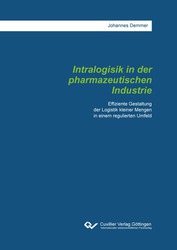| Fachbereiche | |
|---|---|
| Buchreihen (96) |
1378
|
| Nachhaltigkeit |
3
|
| Gesundheitswesen |
1
|
| Geisteswissenschaften |
2365
|
| Medienwissenschaften | 16 |
| Theologie | 57 |
| Philosophie | 102 |
| Rechtswissenschaft | 422 |
| Wirtschaftswissenschaften | 850 |
| Sozialwissenschaften | 416 |
| Sportwissenschaften | 48 |
| Psychologie | 233 |
| Pädagogik | 190 |
| Geschichtswissenschaften | 182 |
| Kunstwissenschaften | 111 |
| Kulturwissenschaften | 166 |
| Literaturwissenschaften | 117 |
| Sprachwissenschaften | 88 |
| Naturwissenschaften |
5406
|
| Ingenieurwissenschaften |
1793
|
| Allgemein |
98
|
|
Leitlinien Unfallchirurgie
5. Auflage bestellen |
|
Erweiterte Suche
Intralogistik in der pharmazeutischen Industrie
Effiziente Gestaltung der Logistik kleiner Mengen in einem regulierten Umfeld
Johannes Demmer (Autor)Vorschau
Leseprobe, PDF (130 KB)
Inhaltsverzeichnis, PDF (100 KB)
Materialfluss und Logistik in der pharmazeutischen Produktion unterliegen den regulatorischen Vorgaben der „Good Manufacturing Practice“ (GMP). Eine sichere und effiziente Gestaltung der Prozesse ist somit nur mit einem gemeinsamen Verständnis der Logistik und der branchenspezifischen GMP-Anforderungen möglich. Diese Untersuchung macht die wechselseitigen Einflüsse sichtbar und messbar.
Über die Stufen der pharmazeutischen Herstellung werden standardisierte Logistikprozesse modelliert. Hieran werden wesentliche Aspekte der Pharmaproduktion aus logistischer Sicht detailliert, z. B. Musterzug, Schleusenprozesse, kontrollierte Umgebungsbedingungen, Chargenmanagement, Informations- und Dokumentationsprozesse. Die Strukturierung erlaubt es auch, GMP-Risiken zu erfassen und ihnen entgegen zu wirken, z. B. Kontamination, Abfallmanagement, Förder- und Lagertechnik, Proben- und Dokumentenlogistik.
Empfehlungen werden abgeleitet und miteinander verglichen, um eine Optimierung der Logistik im GMP-Umfeld und ggfs. eine bessere Umsetzung der Anforderungen zu erreichen.
Beispiele umfassen Aspekte der baulichen Gestaltung bis hin zur Anordnung von Bereichen zueinander sowie des Prozessdesigns. Ergänzt wird dies durch quantitative Ansätze, um die Empfehlungen bzw. (ggf. zusätzliche) GMP-Aufwände bewerten und vergleichbar machen zu können. Insbesondere werden Effekte aus der Produktion in Kampagnen (mit erheblichen Rüst- und Reinigungszeiten), durch strategische Beschaffung sowie Batchmanagement analysiert.
Basierend auf der detaillierten theoretischen Modellierung für die pharmazeutische Industrie können die Ergebnisse auf andere Industrien mit reguliertem Umfeld übertragen werden.
Material-flow and logistics within the pharmaceutical production are subject to the regulatory requirements of “Good Manufacturing Practice” (GMP). To do a safe and efficient process design it is fundamental to have a joint understanding of material-flow processes and industry-specific GMP-requirements. This research visualizes bidirectional impacts and makes them quantifiably.
Standardized material-flow processes are modelled along the different steps of pharmaceutical manufacturing. The model is used to detail essential aspects of the production from a logistics perspective, e.g. sampling, air-lock processes, controlled environment conditions, batch management, information and documentation processes. The structure also allows capturing risks and work to mitigate them, e.g. contamination, waste management, conveying systems, storage technology, sample- and document-logistics.
Recommendations are derived and evaluated to optimize the material-flow processes and logistics in a GMP-environment. In some cases it might be possible to even reach a higher level of GMP-compliance.
Examples include aspects of facility construction, general area layout as well as flow and process design. Quantitative approaches are added to calculate the impact of recommdations provided and – if applicable – additional effort caused by GMP-requirements. Especially effects from a batch-driven manufacturing (with extensive setup and cleaning times), strategic sourcing and batch management in logistics are analyzed.
Based on detailed theoretical foundation for the pharmaceutical industry the results can be transferred to other industries with strict regulatory requirements.
| ISBN-13 (Printausgabe) | 9783736972551 |
| ISBN-13 (E-Book) | 9783736962552 |
| Buchendformat | A4 |
| Sprache | Deutsch |
| Seitenanzahl | 254 |
| Auflage | 1 |
| Erscheinungsort | Göttingen |
| Promotionsort | Duisburg-Essen |
| Erscheinungsdatum | 12.08.2020 |
| Allgemeine Einordnung | Dissertation |
| Fachbereiche |
Betriebswirtschaftslehre
Maschinenbau und Verfahrenstechnik Fertigungs- und Produktionstechnik |
| Schlagwörter | Logistik, Intralogistik, Logistikplanung, Materialfluss, Materialflussplanung, Pharmaindustrie, pharmazeutische Industrie, Wirkstoffherstellung, Formulierung, Verpackung, Effizienz, Regulierung, regulierte Industrien, kleine Mengen, Schleuse, Musterzug, Probennahme, Lager, Reinräume, Reinraumproduktion, Reinraum, Kampagnenfertigung, bauliche Gestaltung, Standortlayout, Risiken, Prozessaufwand, Ressourcenbedarf, Logistics, Intralogistics, logistics design, material flow, material flow design, pharma industry, API production, formulation, packaging, efficiency, GMP, Good Manufacturing Practice, regulated industries, small volumes, airlock design, sampling design, warehouse, cleanroom production, batch production, warehouse construction, site design,site design, development expenses, Produktinnovationen, product innovations, Patentschutz, patent protection, Patentklippe, Unternehmensimage, company image, Diebstahlgefährdung, risk of theft, Reinraumklassen, Intralogistik, Produktionsnähe, production proximity, Logistikkosten, logistics costs, Ressourcennutzung, use of resources, Prozesskette, process chain, Warenausgang, outgoing goods, Wareneingang, goods receipt, Kommissionierung, picking, Einwaage, Mehrwegmanagement, multi-way management, Quarantäneeffekt, Lagertechnik, storage technology |








